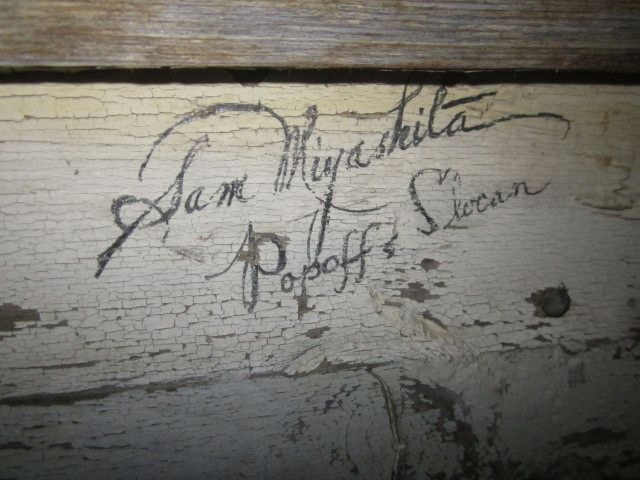You never know what you might find when you start renovating old buildings.
Case in point: the Silvery Slocan Social Centre in Slocan City, built in 1924 and otherwise known as the Legion Hall and Oddfellows Hall, is undergoing renovations to expand its kitchen.
Recently, while the contractor was working on the northwest exterior corner, a number of Japanese names were discovered on the original siding.
Legion president Pat Ashton told me that unfortunately, some of them disappeared in the process: “As he was tearing the asphalt off, you could see it in the paint. But it just peeled off and they disappeared before he could do anything.”
Among the handful that survived, the clearest reads “Sam Miyashita, Popoff, Slocan.” (Popoff was a farm just south of Slocan where Japanese Canadians were interned during World War II.) I haven’t been able to learn anything more about him, although there’s a chef by the same name in Florida.
There’s also “Akiko M.”; what looks like “Teddy Y + Mikyaka”; two more fellows named Sam (or maybe the same one) whose surnames are obscured; either Saku or Takei Sano; and the name or word “Yasy.”
“I imagine that before they put the fake asphalt brick coat on, they signed their names on the old shiplap underneath,” Ashton said. “We’re going to save that portion. When [the contractor] gets to that section, he’s not going to drywall it, but coat it in shellac or varnish to preserve it. We’re also going to take a picture of it,  blow it up and hang it in the hall.”
blow it up and hang it in the hall.”
So what do the names mean? Might they have been part of the crew who put the old siding on?
“I think it’s graffiti,” laughed Chuck Tasaka, an author friend of mine who grew up in Greenwood in the 1950s. “This was quite common back in those days.”
The Slocan hall was a focal point for Japanese Canadians during the internment era, as it was for the rest of the community. The Nikkei National Museum has a great photo of a dance held there in February 1944, which reveals just how little the building has changed.
Meanwhile, during renovations to the second floor of the Hume Hotel last fall, a bottle of Royal Export beer (seen at left) from the original Nelson Brewing Company was uncovered, much to the delight of general manager Ryan Martin. “Who put it there and why?” he wondered. “What did their day look like?”
The renos, which are almost at the drywalling phase, consist of work on six guest rooms and the creation of a new spa and salon called Aura.
Martin plans to pay his discovery forward — with more liquid treasure. “I am going to put in a full bottle of Kootenay Country vodka and an assorted NBC six pack for the next person to discover.”
